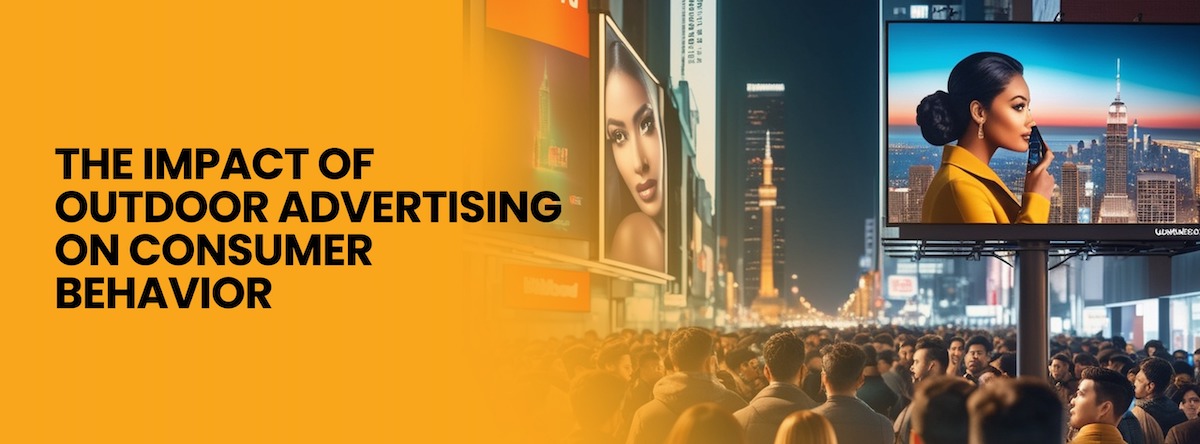
Businesses are always looking for new and efficient ways to draw in their target audience in the ever-changing world of marketing. Even if digital marketing has grown significantly in recent years, outdoor advertising is still a powerful traditional marketing strategy. Outdoor advertising, with its iconic billboards looming over highways and posters gracing bus stations, continues to be a potent weapon in the marketer's toolbox. However, precisely how does it affect the behavior of consumers?
Let's investigate the world of outdoor advertising and how it affects customers
1. Awareness of the Brand and Exposure
Unmatched exposure to a wide range of consumers is provided by outdoor advertising. People are always in contact with outdoor ads, whether they are driving to work, taking leisurely strolls around cities, or just spending time outside. Because the brand's message is ingrained in consumers' thoughts through repeated visibility, this exposure is essential to increasing brand recognition.
2. Drawing Focus
In a world where digital stimuli are everywhere, outdoor advertising has the ability to stand out and draw attention. Effective placement, succinct content, and striking images are essential for capturing onlookers' short attention. Additionally, visually striking and imaginative outdoor advertisements have the power to stick in consumers' minds and encourage recall for the promoted good or service.
3. Influence on Purchase Decisions
Studies have shown that outdoor advertising significantly influences consumer purchasing decisions. Whether it's prompting impulse purchases or shaping long-term brand perceptions, outdoor ads have a measurable impact on consumer behavior. For instance, a well-placed billboard showcasing a refreshing drink on a hot summer day can trigger immediate cravings and drive consumers to make spontaneous purchases.
4. Regional Focused Advertising
The capacity of outdoor advertising to target particular geographic areas and localize messaging is one of its advantages. Companies may customize their outdoor advertising to appeal to the local demographics, culture, and tastes in order to increase relevance and engagement with their target market. By fostering a sense of community and connection, this localized approach increases the advertisement's efficacy.
5. Complementary Role in Integrated Marketing Campaigns
While digital marketing channels offer precise targeting and interactive capabilities, outdoor advertising complements these efforts by providing broad reach and brand reinforcement. Incorporating outdoor ads into an integrated marketing campaign creates a cohesive brand presence across multiple touchpoints, reinforcing brand messaging and driving synergistic effects that amplify overall marketing effectiveness.
6. Reinforcement of Brand Identity
Consistent exposure to outdoor advertising reinforces brand identity and values in the minds of consumers. By consistently showcasing key brand elements such as logos, slogans, and brand colors across various outdoor mediums, businesses can establish a strong brand presence and solidify their positioning in the marketplace. This reinforcement helps to differentiate the brand from competitors and build trust and familiarity among consumers.
7. Integration of Mobile
With the development of technology, outdoor advertising has become more interactive and successful by integrating easily with mobile devices. Customers can interact directly with brands using QR codes, NFC tags, and augmented reality (AR) experiences included in outdoor advertisements, thereby bridging the gap between the real and virtual worlds. In addition to improving the customer experience, this connection gives marketers useful information and insights to help them tailor their advertising.
9. Environmental Sustainability
In an era of increasing environmental awareness, outdoor advertising offers opportunities for brands to demonstrate their commitment to sustainability. Eco-friendly materials, energy-efficient lighting, and creative reuse of existing structures are just some ways in which outdoor advertising can minimize its environmental footprint. By aligning with eco-conscious values, brands can appeal to environmentally-conscious consumers and enhance their brand image.
9. Measureable Return on Investment
Dispelling popular myths, outdoor advertising provides quantifiable return on investment (ROI) using a range of tracking techniques like digital engagement measurements, foot traffic research, and sales attribution models. With the aid of sophisticated analytics tools, marketers may evaluate how outdoor advertisements affect customer behavior and how they contribute to their overall marketing goals. Businesses can maximize their marketing expenditure and improve the efficacy of their outdoor advertising initiatives by utilizing data-driven insights.
10. Quantifiable Return on Investment
Dispelling fallacies, outdoor advertising uses a variety of tracking approaches, such as digital engagement assessments, foot traffic studies, and sales attribution models, to deliver a verifiable return on investment (ROI). Marketers may assess the impact of outdoor ads on consumer behaviour and their contribution to their overall marketing objectives by utilising advanced analytics techniques. By applying data-driven insights, businesses may optimise their marketing budget and raise the effectiveness of their outdoor advertising campaigns.
11. Impact on Impulsive Buying
Impulsive purchases can be effectively stimulated by outdoor advertising. Through tactical placement of advertisements in high-traffic locations or in close proximity to points of sale, businesses may leverage impulsive purchasing behaviour. Outdoor advertisements possess the ability to elicit impulse purchases by appealing to customers' immediate wants and desires, whether it's a compelling deal placed outside a retail store or a visually appealing food item shown on a billboard near a busy junction.
In conclusion, outdoor advertising has a complex influence on consumer behaviour that goes beyond simple visibility to include quantitative return on investment, emotional connection, brand reinforcement, mobile integration, and environmental sustainability. Outdoor advertising is still a flexible and effective tool that companies may use to engage audiences, establish brand equity, and spur corporate growth as they continue to adjust to shifting consumer tastes and technology improvements.